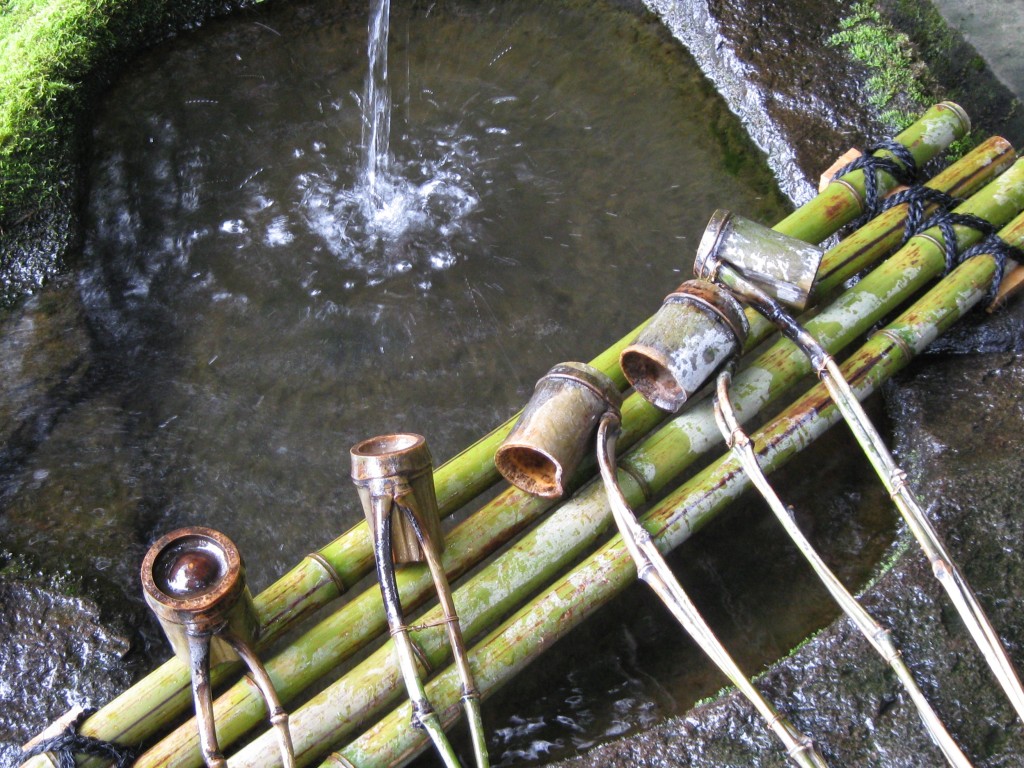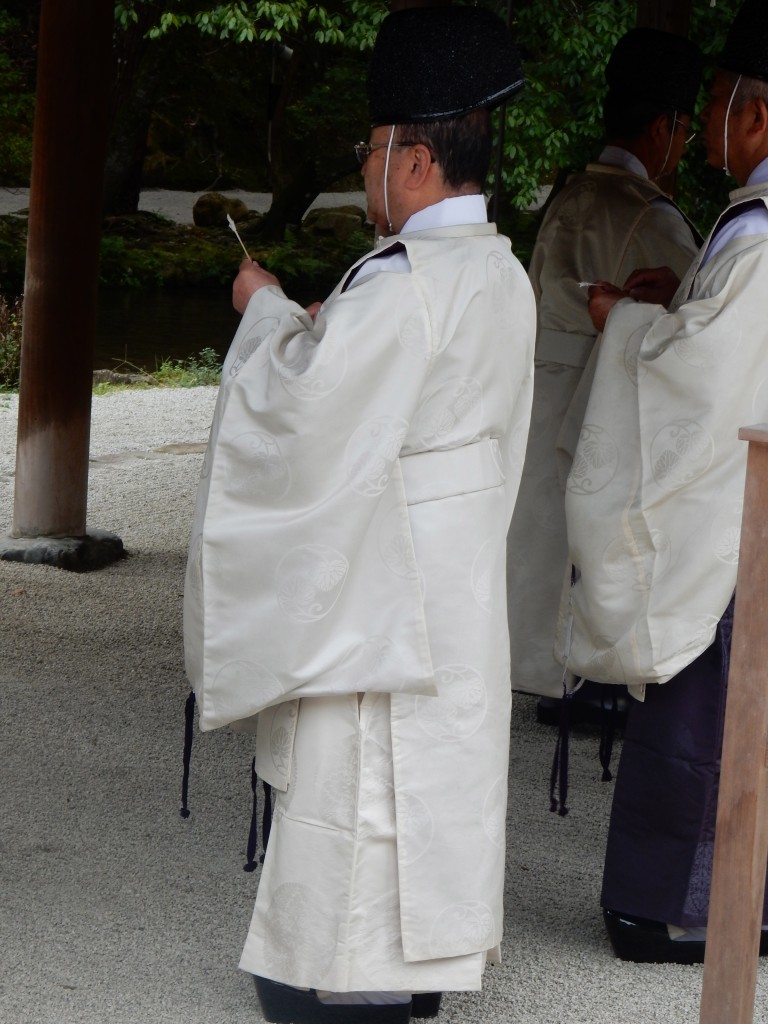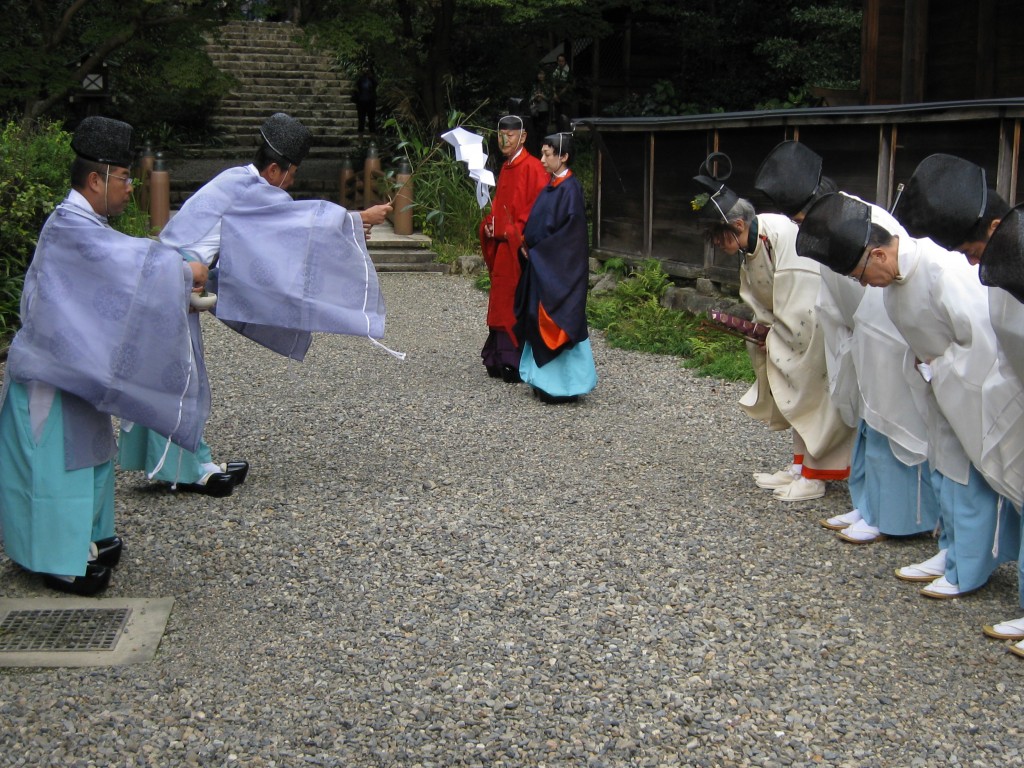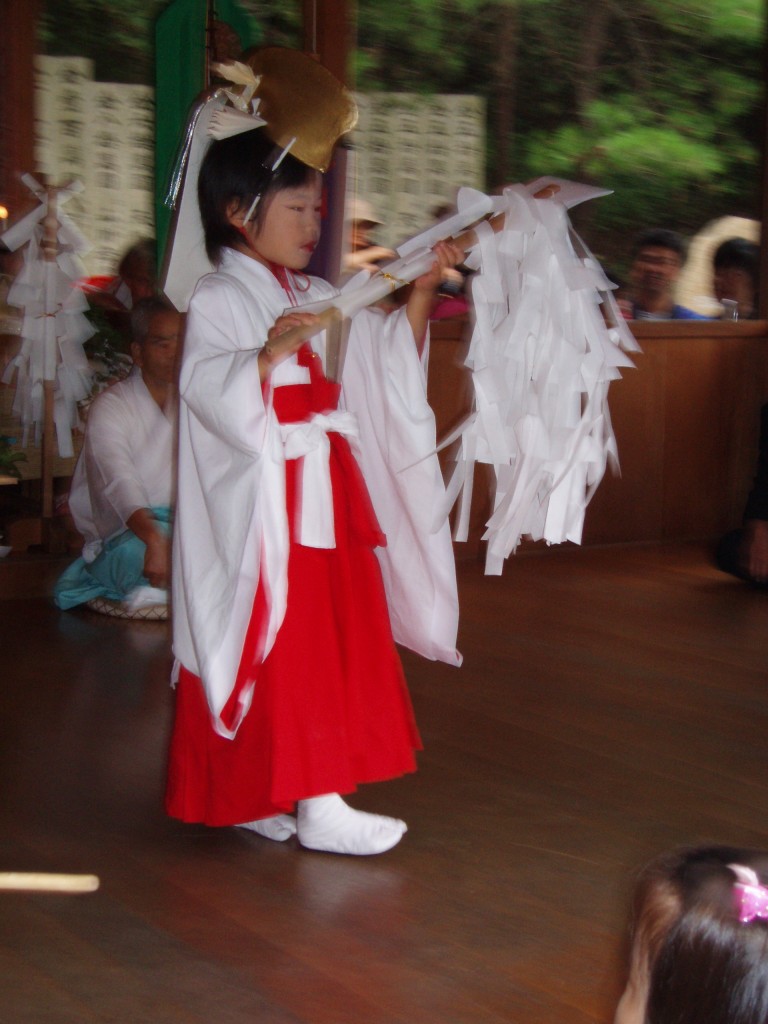
I was once shown round a shrine by a Shinto priest, who claimed the concern with cleanliness and purity was because the high humidity in Japan fostered disease and germs. It struck me as a typical Japanese way of seeing things, as if the practice was somehow special to the country. An alternative viewpoint would be to see the concern with cleanliness as integral to the wider shamanic concern with spiritual purity.
In this way Shinto is very much part of East Asian spirituality as a whole. But whereas shamanism remains a living tradition in Korea and Siberia, Shinto is a fossilised form of shamanism that retains the form though the original intention has been lost. Hence the simple waving of a purification stick (haraigushi) to signify cleansing, which in ancient times may have been carried out by a miko shamaness in tandem with otherworldly spirits.
The piece below about Spiritual Hygiene in Shamanic Healing illustrates what is meant in shamanic terms by impurity. The article demonstrates that the goal of shamanism is restoring a pristine state, which is the essence of Shinto too. Living in a material world means the inevitable accumulation of pollution, and wiping clean our spiritual self is akin to cleaning away the dust that accumulates. When the soul is cleansed, the spirit is pure.
***********************************************************
The following piece is an abridged version of an article by Caitlin Matthews in the magazine Sacred Hoop, issue 86.
WHAT ARE INTRUSIONS?
Shamanically speaking, everything has power and spirit. Power and spirit are not ‘evil’ in themselves, they are neutral, but when they are in the wrong place, we experience this as an ‘evil.’ Take beetles, for example. While beetles are fine in the garden where they eat away diseased foliage, beetles in your bed or on your plate are another matter; I’m sure we would all agree.

Symbolic extraction of spiritual impurity through waving the stick over the body and disposing of 'the pollution' in a nearby stream
Throughout the world, there are clear boundaries about keeping things separate from each other: most cultures, for example, keep a strict barrier between the living and the dead, with people of a certain caste or skill-set there to attend to the deceased’s body. Similarly, when it comes to matters of psychic health and spiritual hygiene, shamans and medicine people have their own craft in separating what has become mixed and bringing clarity and integrity once again.
For most healers, spiritual cleanliness and clearing are akin to housework: we all need to do a little cleaning everyday so that our home environment stays healthy. When spirit intrusions, residues, and miasmas are present in our souls, we can feel unclean, polluted or invaded.
So what is an intrusion? An intrusion can be anything in spirit form that enters, invades or clusters within its host. What do intrusions look like? How do we recognise them? The inheritance of dualistic faiths in our society can still fuel our paranoia, shaping intrusion in human imagination into many monstrous forms. Both the demons and homunculi of medieval times, as well as the resurrected Gothic horrors of the Romantic era, inform our cultural imagination, veering uneasily between the thought of suppressed psychological entities, or forms of uncleanly fears and fancies.
Intrusions can have the appearance of a host or swarm of colonisers, like the gatherings of dirt or residue that you find in a long-forgotten outbuilding where cobwebs and other detritus pile up. An intrusion can also have humanoid forms: ancestral presences who are lost or astray, or who still hold undue influence over the host, or residues of abusive people still alive, whose lives have tangled with our own. Intrusions are rarely depicted, for good reason.
The sense of a ‘foreign body’ is often very clear to the host, who will report feeling a strange displacement that they can’t account for. They may also feel ‘overseen,’ stalked, or ‘uncomfortable’ in an undefined way, overshadowed or in the presence of something alien. Some people have even described this discomfort with a metaphor of indigestion, ‘it’s like I’ve eaten something bad, it just sits there, it doesn’t move, but it feels toxic.’
The nature of dirt of any kind is that it builds up and accumulates. The same kind of thing happens when we do not observe psychic hygiene in our own beings. When there is a gap or space in our power or soul, intrusion can build up there and become a more serious matter.
THE FORMATION OF ENTITIES
Because we live in a sanitised world of tidied-up order, our society has purged the imagination of the kinds of beings that our ancestors feared, beings that they called by a variety of names: demons, imps, incubi etc. Such names are not so helpful to us now because they make us demonise intrusions.
Opportunism is the name of the intrusions’ game. If we leave an opening, something may come in… we can easily see how the spirits of addictions come to fill up empty spaces in our lives… binge drinking, substance abuse or other kinds of behaviour can invite a spirit of intrusion to take up residence within us.
If you are practising your shamanic craft, then you can journey regularly to maintain the pathways of life clearly and keep your practice bright. Good missions to journey on include: ‘What needs to be cleared away so that life can flow once again?’ ‘Reconnect me more strongly with the sources of power and inspiration.’ In this way, in the words of Gandhi:
Your beliefs become your thoughts
Your thoughts become your words
Your words become your actions
Your actions become your habits
Your habits become your values
Your values become your destiny.
*******************************************************
Caitlín Matthews is the author of ‘Singing the Soul Back Home,’ ‘The Psychic Protection Handbook’ and ‘Celtic Visions,’ and is currently at work on her study of the ancestors, ‘The Book of Ancestral Welcome.’ She has had a shamanic practice in Oxford for 25 years. Click here for her website.
For more on the postshamanic nature of Shinto, see an earlier Green Shinto posting here.

Two tools of purification can be seen here, the sakaki branch being waved and in the background the purification stick


Absolutely Fascinating John, I have recently stumbled across your site, and have been enjoying many of your entries these past few hours.
Really look forward to reading more I’m sure over the days and weeks to come.
Thank you for writing in, it helps keep up the motivation for the site.
I have something of an affinity with shinto. I have been a christian for many years, and something I have a cultural and spiritual affinity with, I feel like I am being called to see something more – mystical – in the universe.
This is a fantastic place for research!
The idea of that feeling in one’s heart – like indigestion – I suffer from that, it’s fear, anxiety, depression, something that so many people nowadays feel.
This article is so spot on. Thank you!
Since Shinto is not a religion you can ‘join’, it may have an appeal for those like yourself who incline to the mystical while being alienated by more conventional religions. The open nature of its torii (the gateless gate) makes it seem particularly appealing and undemanding.